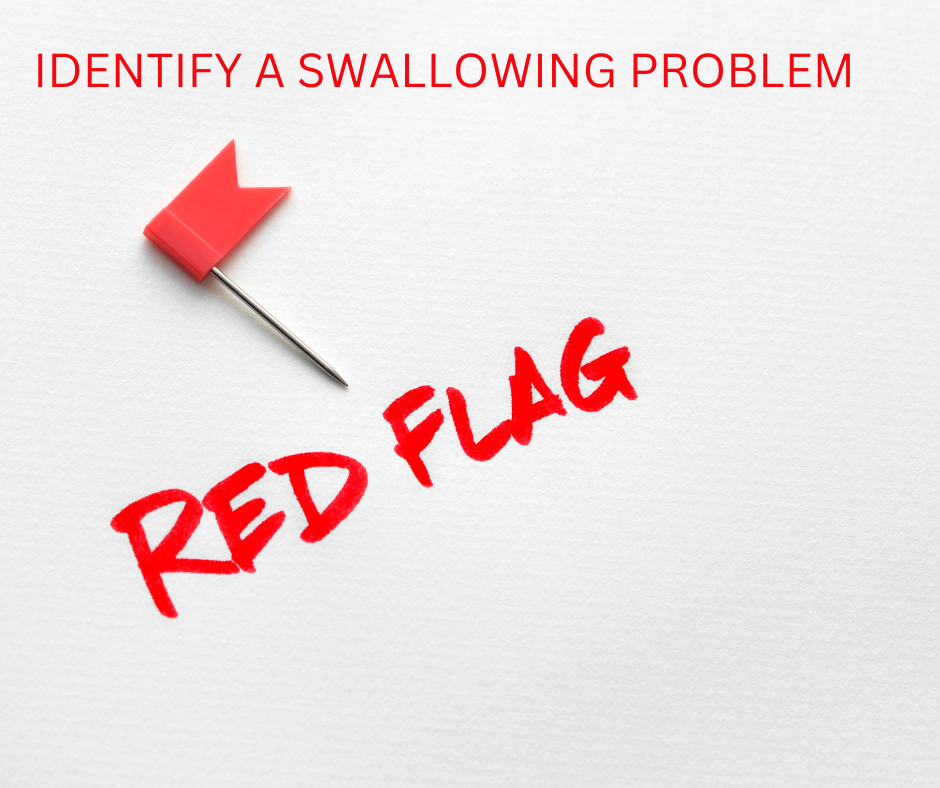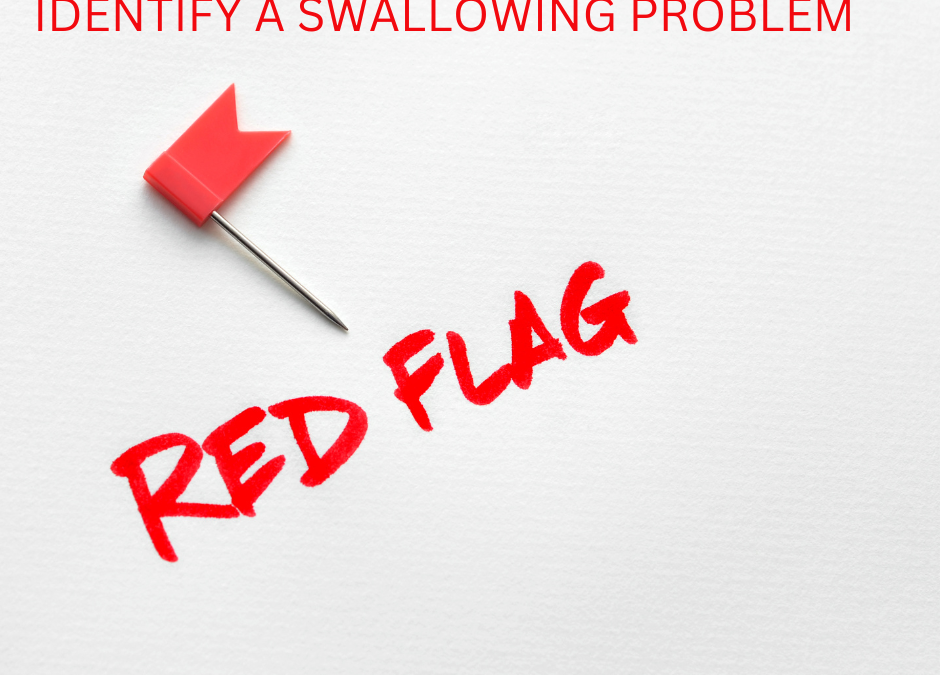
Dear Caregiver,
Are you concerned that your loved one is having swallowing difficulties but don’t know for sure? What signs should you be looking for that would indicate red flags for a swallow problem?
You are not alone as swallowing problems are common in older people. Swallowing may seem like a simple task, buts it’s actually a complex process involving many muscles and nerves working together in a timely fashion to be normal. When something disrupts this process, it can lead to various swallowing problems , medically known as dysphagia.
It can be very overwhelming to navigate this aspect of caregiving. As a speech pathologist I have worked with numerous individuals and their families and caregivers facing swallowing challenges. I’d like to share some important information to help you recognize the red flags that may indicate a swallowing problem in your loved one.
In this blog post, we’ll explore common signs and symptoms of swallowing problems from a caregiver’s perspective. I will give you the information you need to know and what steps to take next. By knowing what to watch for and what to report to your medical providers, you are playing a crucial role in identifying a swallowing problem.

The four phases of swallowing:
On my first visit to see an individual, I may have information in their chart about a known swallowing problem and the etiology or cause for the dysphagia diagnosis. Other times, I am going in blind with no information other than a speech order for a swallowing evaluation.
The act of swallowing is segmented into four phases: oral preparatory phase, oral phase, pharyngeal phase and esophageal phase. Depending on what and where you read, these phases can be named differently and can be broken down into different number of phases. There can be a disorder or problem in one phase only of the swallow or a combination of problems in two or more parts of the swallow.
Swallowing problems can be of a sudden onset nature, but more commonly they have existed over several weeks, months or even years. Over time, individuals with swallowing difficulties adapt their eating habits or modify their diets by avoiding foods that trigger symptoms or have learned a strategy to help them swallow.
These adaptations may help them cope with their problem, but it does not address the underlying issue. This lack of awareness, fear or embarrassment, denial or adaptations without addressing the issue could lead to or exacerbate poor nutrition, weight loss issues, risk of dehydration, risk of respiratory infections and overall contribute negatively to health and wellbeing.
Let’s look at each phase of swallowing , identify signs of common swallow problems and potential causes for each problem. These phases are dynamic and overlap. By no means is this a complete and exhaustive list. Identifying signs is recognizing a potential problem, but is not indicative of a swallow problem.

COMMON SIGNS AND SYMPTOMS OF DYSPHAGIA:
| PHASES OF SWALLOW | SIGNS OF SWALLOW PROBLEM | POTENTIAL CAUSE OF PROBLEM |
| 1. ORAL PREPATORY PHASE | DROOLING, LOSS OF FOOD OR LIQUID FROM LIPS | LIP CLOSURE: LIPS AREN’T CLOSING AROUND CUP, STRAW OR UTENSIL; DECREASED LIP STRENGTH; DECREASED LIP RANGE OF MOTION; DECREASED AWARENESS (COGNITION); DECREASED SENSATION (PARALYSIS); EXCESS SALIVA WITH POOR ABILITY TO MANAGE |
FOOD SCATTERED THROUGHOUT MOUTH VS STAYING TOGETHER IN A FORMED BOLUS | TONGUE MOVEMENT: TONGUE IS NOT MANIPULATING FOOD OR LIQUID IN THE MOUTH; TONGUE IS NOT SHAPING FOOD ; TONGUE IS NOT MOVING FOOD TO TEETH FOR CHEWING; DECREASED TONGUE STRENGTH AND RANGE OF MOTION; DECREASED AWARENESS (COGNITION); DECREASED SENSATION (TONGUE RESECTION, RADIATION OR NERVE DAMAGE, PARALYSIS) | |
MINIMAL OR NO CHEWING ; MASHING FOOD AGAINST ROOF OF MOUTH VS CHEWING; | CHEWING/MASTICATION: NO TEETH; LACKING TEETH; POOR DENTITION; PAIN WITH CHEWING; MOUTH SORES; CAVITIES/INFECTIONS; ILL FITTING DENTURES; LACKS ROTARY CHEWING; HOLDS FOOD IN MOUTH VS CHEWING (COGNITION); PROBLEMS WITH JAW OPEN AND CLOSING; DRY MOUTH; LACKS SALIVA TO MIX WITH FOOD | |
| FOOD POCKETING OR GETTING STUCK IN CHEEKS | PARALYSIS SIDE OF FACE; CHEEKS LACK MUSCLE STRENGTH AND TONE TO KEEP FOOD OUT OF CHEEK ; LACKS AWARENESS (COGNITIVE); DECREASED TONGUE MOVEMENT TO CLEAR FOOD FROM CHEEK | |
| EXCESSIVE CHEWING; TAKES A LONG TIME TO EAT; HOLDING FOOD IN MOUTH | FOOD TEXTURE TOO CHALLENGING ; FATIGUE; SWALLOW GETS WORSE AS MEAL PROGRESSES; COGNITIVE PROBLEM; DECREASED AWARENESS -FORGETTING TO SWALLOW; LACK RECOGNITION OF FOOD; INATTENTION | |
| 2. ORAL PHASE | FOOD REMAINING IN MOUTH AFTER SWALLOW | TONGUE ELEVATION: TONGUE IS NOT ELEVATING TO ROOF OF MOUTH, TONGUE IS NOT PUSHING FOOD OR LIQUID UPWARD AND BACKWARD TOWARD BACK OF MOUTH; REDUCED TONGUE MOVEMENT; REDUCED TONGUE STRENGTH; TONGUE NOT ABLE TO PROPEL BOLUS BACKWARDS; TONGUE NOT RETRACTING FAR ENOUGH TOWARDS BACK OF MOUTH |
| COUGHING OR CHOKING BEFORE THE SWALLOW | TONGUE IS NOT MANAGING FOOD OR LIQUID TO KEEP TOGETHER AND IT IS PREMATURELY GOING DOWN THROAT BEFORE SWALLOW IS TRIGGERED; REDUCED TONGUE STRENGTH | |
| HOLDING FOOD IN MOUTH AND WAITING FOR A SWALLOW | TIMELY SWALLOW: UNABLE TO TRIGGER A SWALLOW OR DELAY IN SWALLOWING; TONGUE WEAKNESS AND NOT PUSHING FOOD TO BACK OF MOUTH | |
| 3. PHARYNGEAL PHASE | FOOD OR DRINK GOING UP NOSE OR COMING OUT NOSE | SOFT PALATE ELEVATION: THE SOFT PALATE IS NOT ELEVATING TO CLOSE OFF NASAL PASSAGE TO PREVENT FOOD OR LIQUID FROM ENTERING NASAL CAVITY DURING THE SWALLOW |
| COUGHING OR CHOKING DURING OR AFTER THE SWALLOW | FOOD OR LIQUID PENETRATING INTO THE LARYNX; DECREASED AIRWAY PROTECTION; ASPIRATION -FOOD AND/OR LIQUID GOING INTO THE LUNGS; DECREASED LARYNGEAL ELEVATION; POOR TIMING OR UNCOORDINATED TIMING OF MUSCLES; VOCAL CORD PROBLEMS | |
| FEELING OF FOOD CAUGHT IN THROAT; THROAT CLEARING; COUGHING | PHARYNGEAL CONSTRICTION: DECREASED PHARYNGEAL CONSTRICTION; FOOD RESIDUAL IN THROAT AFTER THE SWALLOW; FOOD OR LIQUID REMAINING ON THE WALLS OR IN POCKETS OF THE THROAT AFTER THE SWALLOW | |
| 4. ESOPHAGEAL PHASE | FEELING OF FOOD CAUGHT IN THROAT – AT TOP OF ESOPHAGUS | UPPER ESOPHAGEAL SPHINCTER: SPHINCTER NOT OPENING TIMELY OR WIDE ENOUGH FOR FOOD OR LIQUID TO PASS FROM THROAT INTO THE ESOPHAGUS; HAS TO SPIT FOOD BACK OUT; GAGGING, CHOKING AND COUGHING |
| BURPING, PAIN, DISCOMFORT IN THE CHEST;BURNING IN THE CHEST; DISCOMFORT UPPER ABDOMEN | HEARTBURN OR ACID REFLUX | |
| BITTER TASTE , BURPING UP UNDIGESTED FOOD, A FEELING OF THROWING UP ; FEELING FOOD MOVING UP AND DOWN IN YOUR CHEST | REGURGITATION: SYMPTOMS OF GERD /REFLUX | |
| FEELING OF FOOD AND/OR PILLS, GETTING STUCK IN CHEST; FEELING OF FULLNESS IN ESOPHAGUS | POTENTIAL ESOPHAGEAL ISSUES ; NARROWING OF ESOPHAGUS; DECREASED TIMELY EMPTYING OF THE ESOPHAGUS; HERNIA; STRICTURE; WEBBING ETC,. |
COGNITION & DYSPHAGIA:
There is no medical term called cognitive dysphagia but cognition plays a crucial role in the swallowing process. Cognitive dysphagia could be used to describe dysphagia that is primarily driven by cognitive impairments such as dementia and traumatic brain injuries. The etiology of the swallowing problem is cognitive vs. structural or a neuromuscular problem.
Cognitive factors can certainly contribute to swallowing difficulties in some individuals. Cognitively impaired persons may have impairments in the areas of attention, memory, problem solving abilities, and sensory perception, all of which play a role in the swallowing process. It is important that cognitive functioning is taken into consideration when assessing a person for dysphagia and when developing a treatment plan.

EMOTIONAL TOLL OF DYSPHAGIA:
The most obvious signs and symptoms of a swallowing problem are physical in nature. However, dysphagia can have a significant impact on an individuals emotional toll and social habits. Below are additional red flags to observe for or questions to ask your loved ones when considering if your loved one may have a swallowing problem:
- Eating or drinking or taking medications is stressful
- One does not want to eat in public places or outside of the home
- One does not find enjoyment or pleasure in eating any longer
- Your loved one is not able to eat the foods they enjoy
- Ones social life has changed because of their swallowing problem
- Swallowing problem is causing stress, anxiety and/or depression
- Not eating, drinking or taking medications because of swallowing problem
- Fear of choking , fear of not being able to breath or maybe even die

NEXT STEPS TO TAKE:
If your loved one or someone you are caregiving for is experiencing swallowing difficulties, it is crucial for them to seek an assessment from medical professionals. Here are suggested steps to take:
- Schedule An Appointment with Their Primary Care Physician: Your PCP can conduct an initial assessment , discuss the symptoms, and determine the appropriate plan of care.
- Be Prepared to Describe Symptoms: Hopefully the most common red flags listed above will give you the knowledge to talk about the physical and/or emotional characteristics of your particular swallowing problem. It may be helpful to write these down ahead of your appointment so to be thorough and exact in describing what your loved one is experiencing.
- Seek Further Evaluation: Discuss treatment options with your physician. If your physician is in agreement that a diagnosis of dysphagia is suspected, depending on the symptoms a referral to a specialist for further evaluation will be the reasonable next step. This could include a speech-language pathologist, otolaryngologist or ENT (Ear, Nose & Throat doctor), gastroenterologist and/or a neurologist. There are various tests that may be recommended dependent on the type of specialist you see and the type of problem you present with.
- Follow Treatment Recommendations: Treatment for dysphagia varies depending on the underlying cause. The healthcare provider will discuss treatment options based on findings from their evaluations. This may include dietary modifications, swallowing exercises, medications, or surgical interventions.
- Seek Support: Living with dysphagia can be challenging. Knowledge is powerful in helping you understand and manage your swallowing problems. Speech-language pathologists can provide valuable guidance, information and support. This may include teaching on how to modify textures, , how to position a person for optimal safety for oral intake, compensatory swallowing strategies to reduce risk , teaching on aspiration precautions and reflux precautions, and adaptive utensils, cups and dishes for maximizing independence and oral intake.
- Monitor Symptoms: It is vital to follow up with your PCP after a treatment or intervention has been implemented to discuss progress or lack of progress in managing the symptoms of dysphagia. It may be necessary to adjust treatments or seek further diagnostic work ups to get more favorable outcomes.
CONCLUSION:
I am amazed over and over again with how long some individuals live with a swallowing problem and have never mentioned this to their physician before. An appropriate evaluation, diagnosis, and treatment can improve a persons swallowing abilities and improve overall quality of life and health. Swallowing can have a profound impact on daily life. I strongly encourage you seek evaluation and guidance from a qualified healthcare provider for a thorough assessment and dysphagia management plan.
Check out my YouTube video on this topic: https://youtu.be/R4NlFXBufso
Good Luck,
Jean

